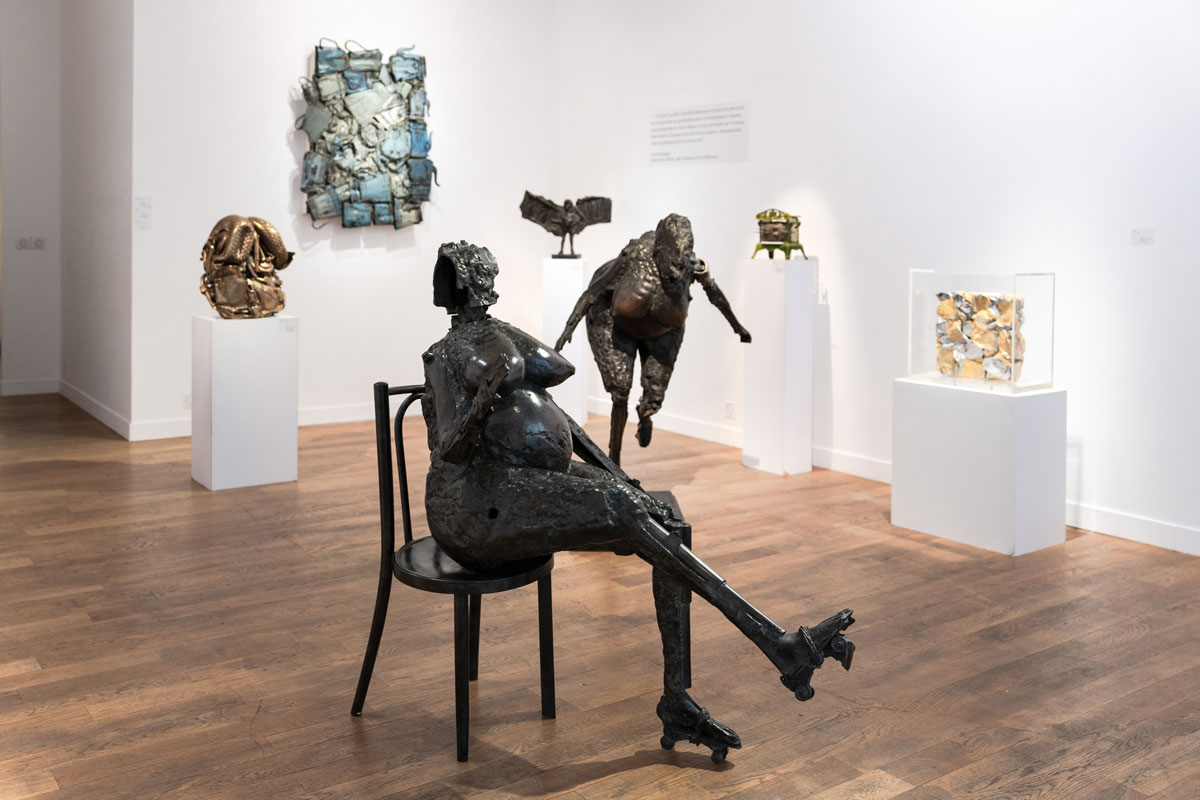Exhibition
César & Hiquily
- Exhibition From 17 October to 30 November 2024
- Opening Thursday 17 October 2024 à 18:00
- Location Espace du 4

Exhibition curator Thierry VEBRE
Text written by Malika Vinot
20th century alchemists
“It is high time for this metal to cease being deadly and a mere instrument of a too mechanical science. Today, the door is wide open for this material to be (finally!) forged and beaten by the peaceful hands of artists.” — Julio González.
A beating heart, a dull and steady rhythm resonating like the repetitive gesture of a worker striking metal. The heat of the forge… Under fire, metal becomes liquid, water turns into steam. Muscles tighten, blood boils… The heart races, the hand stiffens… A few more strikes, the metal is tamed. The machine speeds up. Bit by bit, pieces break off… and then, finally… it bursts.
The ecstasy of creation, the climax of human practice. A composition is born under the rough and firm hands of the sculptor. He exhales, breathless but serene, as he discovers a small piece of his soul ready to be offered to the world.
A true alchemy where metal becomes art, this passion materializes today through the works of two artists, Philippe Hiquily and César, brought together in the new exhibition presented by Galerie LOFT from October 17 to November 30. From iron to brass, from steel to bronze; collected, assembled, cast, welded, hammered, melted, patinated… more than just a material, in their hands, metal becomes a living substance to be tamed. Birds or Compressions, Chickens or Weathervanes, Tightrope Walkers or Cosmonauts, it takes on a thousand forms, each a sublimation of material and space.
However, except for the metal works created in Paris by the three Spanish artists Gargallo, Picasso, and, of course, Julio González, the pioneer of “direct” metalwork, from around 1915-20, metal was still little regarded in sculpture until the mid-20th century. In an article published in Revue Combat on July 20, 1959, critic and poet Alain Bosquet had no doubt that “thanks to three major artists—Germaine Richier, César, and Philippe Hiquily—French sculpture has regained its status as the world’s finest, a position it hadn’t held since the distant days of Rodin and Carpeaux.” What united these three artists, and their undeniable contribution to sculpture, was their shared love for metal. While Richier sadly passed away just days after this article’s publication, the woman nicknamed “The Hurricane” had already left her mark, not only on art history with her hybrid figures and lead works but also on the hearts of the two young artists she mentored. Both had instinctively rejected the so-called “classical” techniques and forms of sculpture, a sentiment César and Hiquily had felt almost from the moment they entered the École des Beaux-Arts in Paris, where they shared seats in the Gimond studio. Moreover, in the harsh post-war period, “noble” materials were too expensive for young artists. Thus, with delight, they preferred to dive into junkyards and industrial wastelands, transforming themselves into true “scrap metal dealers” of art. For both Hiquily, a genius of balances and improbable pairings, and César, a true poet of the dynamic physical processes from compression to expansion, discarded scraps became a major source of inspiration, which they gladly shared.
One anecdote among many is the day Hiquily stumbled upon a lot of small abandoned airplane fins, which César begged him to give him because he immediately knew how to incorporate them into one of his works. Sticking with the aviation theme, César, who had been deeply affected by the tragic death of Léo Valentin, also created during this time a series of figures, Valentin, in welded iron. These works, “adorned with one or two wings reminiscent of the wooden ones used by this modern-day Icarus to glide,” are described in the catalog for the César: The Exhibition at the Centre Pompidou in 2017 as “testifying to César’s oscillation between the representation of the body and the abstraction of the wing, a series that anticipates the Vertical Plates César would undertake the following year.”
At the same time, Hiquily, freshly returned from New York where he had been celebrated after two major exhibitions at the Contemporary Gallery, created an “Action Sculpture” by throwing several scrap metal pieces on the ground and assembling them according to the random composition that had formed on the floor.
For many years, their passion continued to grow. They relentlessly renewed their artistic practice by exploring different types of metals and multiplying creative techniques. Mobile or monumental works, produced in a playful approach to sculpture, reflected their desire to turn what was once merely an industrial material into a genuine medium for aesthetics, combining virtuosity of craftsmanship, visual shocks, and critical reflections on today’s world.
Exhibition views
Video
Portrait • César

Artworks
Sculptures










